Instruments
Farrenc – Trio, Op.45 – Viola
 Trio, Op.45, by Louise Farrenc
Trio, Op.45, by Louise FarrencTranscribed for Viola by C.A.Vater and J.W.Pratt (originally for cello)
Viola Part, PDF $9.99
The Farrenc Trio for Flute, Cello, and Piano, Op.45 is a big romantic piece, at times stirring, sweet, stormy, sad, dramatic, or lively, but always compelling throughout its entire four movements. As a flutist, I have enjoyed playing this piece many times, so I was intrigued and delighted to receive a request from flutist Peter H. Bloom that NSM prepare a transcription of the cello part for viola, so that his group Ensemble Aubade could perform a flute/viola/piano version. As Peter Bloom commented, the Trio is “not just a good piece to have been written by a woman in the 19th century; it’s a very good piece for anyone to have written anytime.” The Trio actually feels perfect for the viola, as most of the original cello part lies within viola range, and sections that do not can be modified for the viola tessitura without straying significantly from the composer’s musical intent. Our edition provides only the transcribed viola part; PDFs of the original score and flute part are freely available at imslp.org. —cav
Viola Part, 12 pages; Total, 16 pages.
PreviewBauer – Sonata, Op.22 – Alto Saxophone
 Sonata, Op.22, by Marion Bauer
Sonata, Op.22, by Marion BauerTranscribed for Alto Saxophone (and piano) by Paul Cohen (originally for viola and piano)
Alto Saxophone Part, PDF $11.79
Paul Cohen is one of America's most sought-after saxophonists for orchestral and chamber concerts and solo recitals. In addition to being a renowned performer and recording artist, he is also a talented arranger, lecturer, and collector of rare and historical instruments. Dr. Cohen holds MM and DMA degrees from the Manhattan School of Music; he currently serves on the faculties of the Manhattan School of Music and Rutgers University. We at NSM were pleased for the opportunity to collaborate with him on this publication of his transcription of Marion Bauer’s Sonata for alto saxophone.
from Dr. Paul Cohen’s preface to the NSM edition © April 7, 2021:
“Bauer composed this sonata in 1932 or 1935. It originally was written for viola, and dedicated to the memory of her friend and colleague, Albert Stoessel who was a distinguished American violinist, conductor, author, composer, and educator in the 20th century. Bauer soon after created her own idiomatic transcription for clarinet and piano, and the sonata was published as a work for viola or clarinet in 1951. It is revealing to see the differences in the viola and clarinet versions. The piano part remains unchanged in both.
 There is a history of music for viola successfully adapted for saxophone by the composers. Fernande Decruck’s Sonata (1943) for saxophone and piano (or orchestra) was originally written for viola, as was Ross Lee Finney’s Sonata in A Minor from 1937 (viola and piano), adapted for saxophone in the early 1970s. Several works for alto saxophone and orchestra written for the American saxophonist Elise Hall were originally written for viola, including Florent Schmitt’s Legende (1918) and Choral Variee´ (1903) by Vincent D’Indy. Adolph Busch composed his Suite for violin and either viola or alto saxophone in 1926, while in 1923 Darius Milhaud replaced the viola with the saxophone in La Creation du Monde literally positioning the saxophone in the viola chair in the string section. My saxophone adaptation of Bauer’s Sonata combines elements of the clarinet and viola versions, creating a version appropriate for the alto saxophone. This includes changes in range, articulation, phrasing and dynamics to create an idiomatic (though challenging) version for the alto saxophone faithful to the musical intent of the composer.”
There is a history of music for viola successfully adapted for saxophone by the composers. Fernande Decruck’s Sonata (1943) for saxophone and piano (or orchestra) was originally written for viola, as was Ross Lee Finney’s Sonata in A Minor from 1937 (viola and piano), adapted for saxophone in the early 1970s. Several works for alto saxophone and orchestra written for the American saxophonist Elise Hall were originally written for viola, including Florent Schmitt’s Legende (1918) and Choral Variee´ (1903) by Vincent D’Indy. Adolph Busch composed his Suite for violin and either viola or alto saxophone in 1926, while in 1923 Darius Milhaud replaced the viola with the saxophone in La Creation du Monde literally positioning the saxophone in the viola chair in the string section. My saxophone adaptation of Bauer’s Sonata combines elements of the clarinet and viola versions, creating a version appropriate for the alto saxophone. This includes changes in range, articulation, phrasing and dynamics to create an idiomatic (though challenging) version for the alto saxophone faithful to the musical intent of the composer.”For additional information about Marion Bauer, please see the text excerpted from Peter H. Bloom’s preface to NSM’s 2014 publication of his transcription of the Sonata for alto flute.
We provide only the transcribed alto saxophone part in our edition; a pdf of the piano score is available from imslp.org.
Alto Saxophone Part, 11 pages; Total, 14 pages
PreviewDvořák – Romance, Op. 11 – trans. Clarinet
 Romance, Op. 11 by Antonín Dvořák
Romance, Op. 11 by Antonín DvořákTranscribed for B♭ Clarinet by C. A. Vater (originally for violin)
Part for B♭ Clarinet, PDF $6.97
Czech composer Antonín Dvořák based his Romance, Opus 11 on the slow movement of his String Quartet in F minor, composed in 1873, re-working that Andante con moto quasi allegretto to create two versions of the Romance, one for solo violin and orchestra (B.39) and another for solo violin and piano (B.38). The Romance is one of Dvořák’s most magnificent melodic works, teaming with romance, lyricism, and emotional intensity. Understandably, the piece became extremely popular and has been transcribed for several other instruments, including viola, cello, guitar, and flute. In creating an NSM edition of the work for clarinet (and piano), we have incorporated several changes in the solo part to account for sonic differences between the clarinet and the violin. In so doing, every effort has been made to maintain the spirit, character, and flow of Dvořák’s original composition. We provide here our transcribed B♭ clarinet part only; the score for violin and piano is readily available in the public domain as a free pdf download from imslp.org, and that piano part can be used in performance along with our clarinet part.
B♭ Clarinet part, 4 pages; Total, 6 pages.
PreviewSchumann, Clara – Sechs Lieder - trans. for Alto Flute (and piano)
 Sechs Lieder, by Clara Schumann
Sechs Lieder, by Clara SchumannTranscribed for Alto Flute by C. A. Vater
Part for Alto Flute (in lieu of voice); PDF $5.99
In her Sechs Lieder, Op. 13, Clara Schumann set to music six German poems—two written by Heinrich Heine (Ich stand in dunklen Träumen and Sie liebten sich beide), three by Emanuel Geibel (Liebeszauber, Der Mond kommt still gegangen, and Die stille Lotosblume) and one by Friedrich Rückert (Ich hab’ in deinem Auge). Many of Clara Schumann’s songs were composed as gifts for her beloved husband Robert; they are romantic, melodic and highly expressive, and the Sechs Lieder of Op. 13 appropriately convey the broad array of intense emotions portrayed in the poetry that inspired them. These songs, which are absolutely charming, are nicely adaptable for a solo instrument in lieu of voice. They have been transcribed previously for violin or cello, and likely other instruments as well, but are particularly lovely when played on either alto flute or clarinet, instruments for which the voice line falls completely in range. Our Noteworthy Sheet Music editions of Op. 13 for alto flute or clarinet do not include re-notated versions of the score, since a high-quality PDF of the original piano and voice score is available free of charge in the public domain, and that piano accompaniment works perfectly well with our instrumental transcriptions of the voice line. The score we used when creating our parts may be downloaded from the IMSLP website. For NSM’s clarinet transcription of the Sechs Lieder voice line, please click the link.
Alto Flute Part, 4 pages; Total, 6 pages.
Preview
Schumann, Clara – Sechs Lieder - trans. for Clarinet (and piano)
 Sechs Lieder, by Clara Schumann
Sechs Lieder, by Clara SchumannTranscribed for Clarinet by C. A. Vater
Part for B-flat Clarinet (in lieu of voice); PDF $5.99
In her Sechs Lieder, Op. 13, Clara Schumann set to music six German poems—two written by Heinrich Heine (Ich stand in dunklen Träumen and Sie liebten sich beide), three by Emanuel Geibel (Liebeszauber, Der Mond kommt still gegangen, and Die stille Lotosblume) and one by Friedrich Rückert (Ich hab’ in deinem Auge). Many of Clara Schumann’s songs were composed as gifts for her beloved husband Robert; they are romantic, melodic and highly expressive, and the Sechs Lieder of Op. 13 appropriately convey the broad array of intense emotions portrayed in the poetry that inspired them. These songs, which are absolutely charming, are nicely adaptable for a solo instrument in lieu of voice. They have been transcribed previously for violin or cello, and likely other instruments as well, but are particularly lovely when played on either alto flute or clarinet, instruments for which the voice line falls completely in range. Our Noteworthy Sheet Music editions of Op. 13 for alto flute or clarinet do not include re-notated versions of the score, since a high-quality PDF of the original piano and voice score is available free of charge in the public domain, and that piano accompaniment works perfectly well with our instrumental transcriptions of the voice line. The score we used when creating our parts may be downloaded from the IMSLP website. For NSM’s alto flute transcription of the Sechs Lieder voice line, please click the link.
B-flat Clarinet Part, 4 pages; Total, 6 pages.
Preview
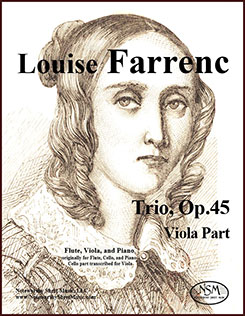 Trio, Op.45, by Louise Farrenc
Trio, Op.45, by Louise Farrenc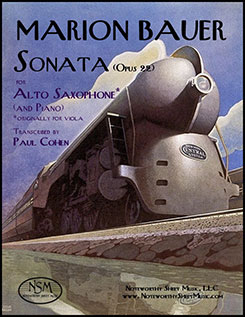
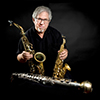 There is a history of music for viola successfully adapted for saxophone by the composers. Fernande Decruck’s Sonata (1943) for saxophone and piano (or orchestra) was originally written for viola, as was Ross Lee Finney’s Sonata in A Minor from 1937 (viola and piano), adapted for saxophone in the early 1970s. Several works for alto saxophone and orchestra written for the American saxophonist Elise Hall were originally written for viola, including Florent Schmitt’s Legende (1918) and Choral Variee´ (1903) by Vincent D’Indy. Adolph Busch composed his Suite for violin and either viola or alto saxophone in 1926, while in 1923 Darius Milhaud replaced the viola with the saxophone in La Creation du Monde literally positioning the saxophone in the viola chair in the string section. My saxophone adaptation of Bauer’s Sonata combines elements of the clarinet and viola versions, creating a version appropriate for the alto saxophone. This includes changes in range, articulation, phrasing and dynamics to create an idiomatic (though challenging) version for the alto saxophone faithful to the musical intent of the composer.”
There is a history of music for viola successfully adapted for saxophone by the composers. Fernande Decruck’s Sonata (1943) for saxophone and piano (or orchestra) was originally written for viola, as was Ross Lee Finney’s Sonata in A Minor from 1937 (viola and piano), adapted for saxophone in the early 1970s. Several works for alto saxophone and orchestra written for the American saxophonist Elise Hall were originally written for viola, including Florent Schmitt’s Legende (1918) and Choral Variee´ (1903) by Vincent D’Indy. Adolph Busch composed his Suite for violin and either viola or alto saxophone in 1926, while in 1923 Darius Milhaud replaced the viola with the saxophone in La Creation du Monde literally positioning the saxophone in the viola chair in the string section. My saxophone adaptation of Bauer’s Sonata combines elements of the clarinet and viola versions, creating a version appropriate for the alto saxophone. This includes changes in range, articulation, phrasing and dynamics to create an idiomatic (though challenging) version for the alto saxophone faithful to the musical intent of the composer.”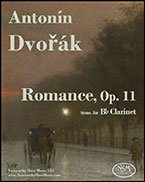 Romance, Op. 11 by Antonín Dvořák
Romance, Op. 11 by Antonín Dvořák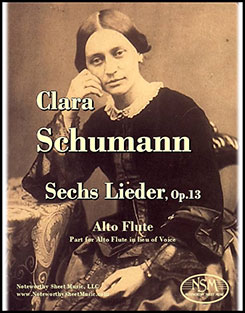 Sechs Lieder, by Clara Schumann
Sechs Lieder, by Clara Schumann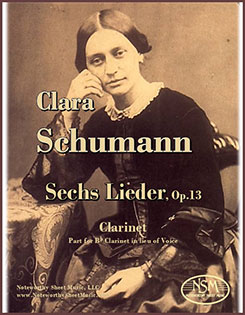 Sechs Lieder, by Clara Schumann
Sechs Lieder, by Clara Schumann